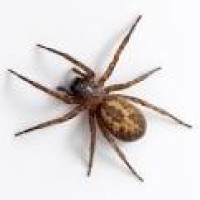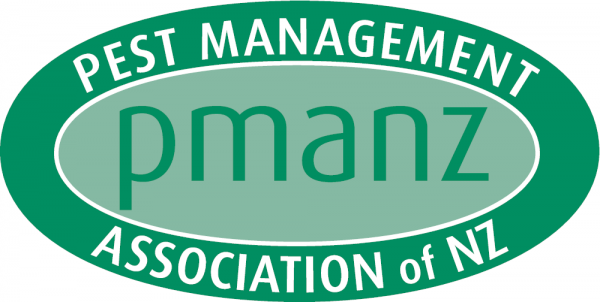Pest Information » Spiders
Spiders

Introduction
There are over 35,000 species of spiders world-wide. Many species of spiders are household pests. Wherever their food is available, spiders are likely to be found. All spiders are predators, feeding mainly on insects and other small arthropods.
Most spiders are nocturnal or active at night and will scurry away when disturbed unless they are tending egg sacs or young. During the day, they usually remain hidden and inactive in cracks and crevices, their webs, etc. Spider bites usually result only with great provocation such as squeezing or handling. Bites usually occur when the males are wandering about searching for females or when people clean out neglected places such as basements, attics, or garages, or put on seldom-used clothing. Many spiders cannot penetrate human skin with their fangs and the bite of those that can, usually results in no more than a slight swelling and inflammation. Always consult a physician if a spider bite is suspected. It is particularly important to capture and take the suspect spider along for identification purposes.
Spiders in New Zealand and Bites
Whilst there are an estimated 2,500 species of spider in New Zealand, confirmed bites are relatively rare occurrences. Although isolated incidents of spider bites have been reported in New Zealand associated with half a dozen or so species, in reality, only the Latrodectus species are documented to be venomous to humans. Australian redback spiders (L. hasselti) are commonly intercepted on imported goods, but there seem to be only isolated populations of these spiders in this country. Therefore, despite being a regular hazard to humans in Australia, the same does not apply in New Zealand. There are records of envenomation by the native katipo (L. atritus and L. katipo), but since these are sparsely distributed and reclusive, bites are rare. There are two Whitetail spiders, Lampona cylindrata and L. murina, which have been in New Zealand for more than 100 years. They are nocturnal and often associated with human dwellings. Whilst not aggressive to humans, they will bite if provoked. The bite is immediately painful, so it is usually possible to see and catch the spider.
Background
Despite little scientific evidence that bites by White-tail spiders (Lampona cylindrata and L. murina) are a threat to human health in New Zealand or elsewhere, there have been at least 19,255 claims to ACC in the past 10 years.
In a review of 130 confirmed White-tail spider bites in Australia, there were no cases of necrotising arachnid ism or confirmed infections.3 Most bites, when they occurred, did so indoors, at night, following accidental contact with the White-tail spider from bedclothes, towels or linen. The median duration of effects was 24 hours (range, 1-168 hours). There were three distinct clinical patterns: pain only (21%), pain and red marks for <24 hours (35% ), and a persistently painful or irritating red lesion (44%). Studies of the cytotoxic effects of White-tail spider venom showed it has little potential to cause necrosis.
So what conditions do patients claiming to have been bitten by White-tail spiders have? An informal email survey of New Zealand dermatologists suggests that patients have a myriad of different skin conditions, but very few were attributable to a bite by a spider.
Diagnostic Criteria
The following basic diagnostic criteria for White-tail spider bites are recommended:
1. A White-tail spider must be observed in the act of biting (not just observed in the vicinity)3
2. Bites are immediately symptomatic
3. Puncture wounds are usually visible in the first 24 hours
4. Reaction in most cases should settle within 72 hours
Ideally the spider should be caught and sent for proper taxonomic identification (see Derraik et al.) for guidance in this regard), although digital photography may be a reasonable alternative.
Differential Diagnosis
Cases in New Zealand that do not fulfil the above criteria are unlikely to have been caused by White-tail spider bites. First consider other insect bites such as fleas, 'sandflies' (Simuliidae) or mosquitoes, particularly if they are itchy. If there
is a suggestion of infection, consider Staphylococcus aureus folliculitis, ecthyma or cellulitis. If the lesion persists, consider inflammatory dermatoses and if the lesion blisters, consider one of the many blistering disorders.
Management of Bites
Most White-tail spider bites will settle with no treatment. Ice can be applied for immediate pain control, followed by standard doses of anti-inflammatories and/or anti-histamines for symptomatic relief. Secondary infection of any broken skin can occur: treat initially with an antiseptic cream such as 1% hydrogen peroxide or 10% povidone-iodine. Rarely cellulitis can develop: consider treatment for Streptococcus or Staphylococcus aureus infection with oral flucloxacillin (erythromycin if allergic to penicillin).
For more detailed information follow the link - ACC Review 42 April 2009 - White Tail Spiders
Follow this for information on these spiders, their lookalikes and what to do in case you are bitten or click on the link below.
www.healthed.govt.nz/resource/spiders-new-zealand
Contact
For further information about spider bites and venom contact:
Control: (Spider control is a 6-step process)
There are over 35,000 species of spiders world-wide. Many species of spiders are household pests. Wherever their food is available, spiders are likely to be found. All spiders are predators, feeding mainly on insects and other small arthropods.
Most spiders are nocturnal or active at night and will scurry away when disturbed unless they are tending egg sacs or young. During the day, they usually remain hidden and inactive in cracks and crevices, their webs, etc. Spider bites usually result only with great provocation such as squeezing or handling. Bites usually occur when the males are wandering about searching for females or when people clean out neglected places such as basements, attics, or garages, or put on seldom-used clothing. Many spiders cannot penetrate human skin with their fangs and the bite of those that can, usually results in no more than a slight swelling and inflammation. Always consult a physician if a spider bite is suspected. It is particularly important to capture and take the suspect spider along for identification purposes.
Spiders in New Zealand and Bites
Whilst there are an estimated 2,500 species of spider in New Zealand, confirmed bites are relatively rare occurrences. Although isolated incidents of spider bites have been reported in New Zealand associated with half a dozen or so species, in reality, only the Latrodectus species are documented to be venomous to humans. Australian redback spiders (L. hasselti) are commonly intercepted on imported goods, but there seem to be only isolated populations of these spiders in this country. Therefore, despite being a regular hazard to humans in Australia, the same does not apply in New Zealand. There are records of envenomation by the native katipo (L. atritus and L. katipo), but since these are sparsely distributed and reclusive, bites are rare. There are two Whitetail spiders, Lampona cylindrata and L. murina, which have been in New Zealand for more than 100 years. They are nocturnal and often associated with human dwellings. Whilst not aggressive to humans, they will bite if provoked. The bite is immediately painful, so it is usually possible to see and catch the spider.
Background
Despite little scientific evidence that bites by White-tail spiders (Lampona cylindrata and L. murina) are a threat to human health in New Zealand or elsewhere, there have been at least 19,255 claims to ACC in the past 10 years.
In a review of 130 confirmed White-tail spider bites in Australia, there were no cases of necrotising arachnid ism or confirmed infections.3 Most bites, when they occurred, did so indoors, at night, following accidental contact with the White-tail spider from bedclothes, towels or linen. The median duration of effects was 24 hours (range, 1-168 hours). There were three distinct clinical patterns: pain only (21%), pain and red marks for <24 hours (35% ), and a persistently painful or irritating red lesion (44%). Studies of the cytotoxic effects of White-tail spider venom showed it has little potential to cause necrosis.
So what conditions do patients claiming to have been bitten by White-tail spiders have? An informal email survey of New Zealand dermatologists suggests that patients have a myriad of different skin conditions, but very few were attributable to a bite by a spider.
Diagnostic Criteria
The following basic diagnostic criteria for White-tail spider bites are recommended:
1. A White-tail spider must be observed in the act of biting (not just observed in the vicinity)3
2. Bites are immediately symptomatic
3. Puncture wounds are usually visible in the first 24 hours
4. Reaction in most cases should settle within 72 hours
Ideally the spider should be caught and sent for proper taxonomic identification (see Derraik et al.) for guidance in this regard), although digital photography may be a reasonable alternative.
Differential Diagnosis
Cases in New Zealand that do not fulfil the above criteria are unlikely to have been caused by White-tail spider bites. First consider other insect bites such as fleas, 'sandflies' (Simuliidae) or mosquitoes, particularly if they are itchy. If there
is a suggestion of infection, consider Staphylococcus aureus folliculitis, ecthyma or cellulitis. If the lesion persists, consider inflammatory dermatoses and if the lesion blisters, consider one of the many blistering disorders.
Management of Bites
Most White-tail spider bites will settle with no treatment. Ice can be applied for immediate pain control, followed by standard doses of anti-inflammatories and/or anti-histamines for symptomatic relief. Secondary infection of any broken skin can occur: treat initially with an antiseptic cream such as 1% hydrogen peroxide or 10% povidone-iodine. Rarely cellulitis can develop: consider treatment for Streptococcus or Staphylococcus aureus infection with oral flucloxacillin (erythromycin if allergic to penicillin).
For more detailed information follow the link - ACC Review 42 April 2009 - White Tail Spiders
Follow this for information on these spiders, their lookalikes and what to do in case you are bitten or click on the link below.
www.healthed.govt.nz/resource/spiders-new-zealand
Contact
For further information about spider bites and venom contact:
- National Poisons Centre 0800 POISON [0800 764 766]
- Local DHB public health unit Ministry of Health www.moh.govt.nz
- Healthline 0800 611 116
- For reporting spiders associated with recently imported goods, contact MPI 0800 809 966
Control: (Spider control is a 6-step process)
- Inspection.
- Identification.
- Prevention.
- Sanitation.
- Mechanical measures.
- Pesticide application.
Related Content
- Code of Practice for the Food Industry
- Using Pesticides Around the Home
- Stay safe when using Poisons around the home
- Advice for Vets about rodenticide poisoning
- Ants
- Bed Bugs
- Bees
- Black Beetle
- Black Field Cricket
- Brown Marmorated Stink Bug
- Click Beetle
- Cluster Flies
- Cockroaches
- Flies
- Mice
- Mosquitoes
- Rats
- Spiders
- Tropical House Cricket
- Wasps
